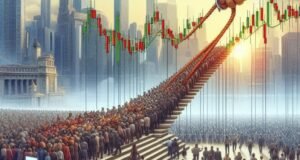Imagine a symphony played across continents. In Tokyo, it’s minimalist and disciplined. In Mumbai, it’s chaotic yet melodic. In New York, bold brass instruments charge ahead with aggression. Now imagine trying to conduct this entire orchestra using only Western sheet music. You’ll miss the rhythm, misread the cues, and lose the harmony.

That’s exactly what happens when quantitative models ignore cultural context.
Welcome to the world of Ethno-Quant Market Modeling—where prop trading evolves beyond cold numbers to include local investor psychology, regional behavior patterns, and cultural trading biases.
In the high-speed realm of prop trading, where alpha is hunted in milliseconds, this might seem unnecessary—until you realize it’s the missing piece of the puzzle in many global strategies.
The Illusion of Universality
Traditional quant models often assume market participants act the same globally: they chase momentum, fear drawdowns, and respond to earnings the same way. But that assumption is not just flawed—it’s blind.
For instance:
- Japanese retail traders often “trade the trend” but paradoxically sell strength due to risk aversion rooted in cultural values of balance and modesty.
- Middle Eastern investors may exhibit longer holding periods during certain religious cycles, impacting intraday liquidity.
- Indian market participants often show herd behavior during earnings season due to community-based investing culture.
If you feed standard models into these markets without adjusting for these patterns, you’re not trading the market—you’re trading a shadow.
That’s where Ethno-Quant Modeling redefines the game for elite prop trading desks.
Objection 1
“Aren’t markets efficient regardless of culture?”
Response:
Markets may be globally connected—but investors are still local humans, shaped by stories, rituals, holidays, and habits. Prop trading is about exploiting inefficiencies, and cultural nuances are a systematic inefficiency hiding in plain sight.

Imagine building a volatility model in South Korea without accounting for Chuseok holiday liquidity drops, or backtesting price reactions in China without noting government messaging through state media. Your model might be brilliant—just not relevant.
Objection 2
“Isn’t this subjective? How can culture be quantified?”
Response:
Culture is qualitative—but its impact leaves quantitative footprints.
Ethno-Quant models extract signals from:
- Festival-induced trading cycles
- Historical reaction asymmetry to the same global event (like Fed hikes) in different markets
In the hands of a seasoned prop trading team, these variables become alpha-generating features, enriching models with a human dimension wrapped in numbers.
The Folklore Engine of Prop Trading
Picture the global financial system not as a machine, but as a mythical beast, made of tribes, traditions, and truths.
Ethno-Quant Market Modeling is the folklore engine behind modern prop trading—turning local behavior into statistical insight.
It’s the quant version of reading the room—except the room is an entire nation’s behavioral code.
Strategic Value for Prop Trading Firms
For a prop trading desk that wants to scale across continents, Ethno-Quant Modeling acts as a local interpreter, helping strategies travel well.
Benefits include:
- Reduced signal noise in culturally reactive markets
- Localized stop-loss calibration based on behavioral thresholds
- More accurate volatility clustering in culturally driven trading periods
- Improved cross-border arbitrage models, adjusting for herd timing or hesitation
This allows firms not only to localize their alpha capture—but to respect the rhythm of each market’s heartbeat.
In the world of prop trading, where milliseconds and micrometrics dominate, the cultural layer may seem soft. But it’s this very soft data that gives your models empathy—the ability to feel before they act.
Ethno-Quant Market Modeling isn’t about trading folklore. It’s about quantifying the myths that move markets, and using them to enhance strategy precision.
Because behind every chart, there’s a culture. And behind every efficient prop desk, there’s an edge the market didn’t see coming.




